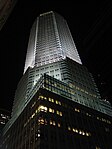Manhattan Institute for Policy Research
1977 establishments in New York CityAll Wikipedia neutral point of view disputesConservative organizations in the United StatesHarv and Sfn no-target errorsManhattan Institute for Policy Research ... and 5 more
Organizations based in ManhattanPolitical and economic think tanks in the United StatesThink tanks established in 1977Universities and colleges accredited by the Council on Occupational EducationWikipedia neutral point of view disputes from September 2020

The Manhattan Institute for Policy Research (renamed in 1981 from the International Center for Economic Policy Studies) is a conservative 501(c)(3) non-profit American think tank focused on domestic policy and urban affairs, established in Manhattan in 1977 by Antony Fisher and William J. Casey. The organization states its mission is to "develop and disseminate new ideas that foster greater economic choice and individual responsibility". Its message is communicated through books, articles, interviews, speeches, op-eds, and through the institute's quarterly publication City Journal. In general, the Manhattan Institute promotes free-market economics.
Excerpt from the Wikipedia article Manhattan Institute for Policy Research (License: CC BY-SA 3.0, Authors, Images).Manhattan Institute for Policy Research
East Helmsley Walk, New York Manhattan
Geographical coordinates (GPS) Address Nearby Places Show on map
Geographical coordinates (GPS)
| Latitude | Longitude |
|---|---|
| N 40.754275 ° | E -73.97747 ° |
Address
Grand Central Terminal
East Helmsley Walk
10169 New York, Manhattan
New York, United States
Open on Google Maps







